|
|
 |
Fiche d'espèce de Copépode |
|
|
Calanoida ( Ordre ) |
|
|
|
Eucalanoidea ( Superfamille ) |
|
|
|
Eucalanidae ( Famille ) |
|
|
|
Eucalanus ( Genre ) |
|
|
| |
Eucalanus elongatus (Dana, 1849) (F,M) | |
| | | | | | | Syn.: | Calanus elongatus Dana,1849; no Sars, 1925 (p.20);
? Calanus erythrochilus Leuckart,1859;
No Eucalanus spinifer T. Scott, 1894 b (p.29, figs.F);
? Eucalanus atlanticus Wolfenden, 1904 (p.113); van Breemen, 1908 a (p.15); Candeias, 1926 (p.27); Rose, 1933 a (p.69, fig. juv.M); Unterüberbacher, 1964 (p.15, Rem.); Sameoto & al., 2002 (p.12);
Non Eucalanus giesbrechti Mori, 1937; Ohtsuka & al., 2015 (p.123, Rem.: p.125);
no Eucalanus elongatus : Esterly, 1905 (p.131); Campbell, 1929 (p.308);
? Eucalanus elongatus hyalinus : Morris, 1970 (p.2300);
No Eucalanus elongatus Park, 1968 (p.538, figs.F,M); No synonym of Eucalanus giesbrechti in Ohtsuka & al., 2015 (p.123, Table 2);
? Eucalanus elongatus : Isari & al., 2011 (p.51, Table 2, abundance vs distribution, in Thracian Sea); Benedetti & al., 2016 (p.159, Table I, fig.1, functional characters); Marques-Rojas & Zoppi de Roa, 2017 (p.495, Table 1).
? Eucalanus elongatus elongatus : Acha & al., 2020 (p.p.1, Table 3: occurrence % vs ecoregions, Table 5: indicator ecoregions). | | | | Ref.: | | | Giesbrecht, 1892 (part., p.131,150, figs.F,M); Giesbrecht & Schmeil, 1898 (part., p.20); Cleve, 1904 a (p.189); Sewell, 1929 (p.48); Rose, 1933 a (p.67, figs.F,M, non localisations); Vervoort, 1946 (p.84, Rev., F,M, juv.); no atlantic forms: [Farran, 1908 b (p.21); With, 1915 (p.48, figs.F,M); Pesta, 1920 (p.498); Lysholm & Nordgaard, 1921 (p.8); [Rose, 1925 (p.151)]; Farran, 1926 (p.230); 1929 (part. p.207, 218); Rose, 1929 (p.14)]; [Rose, 1933, p.67, figs.F,M)]; ? Sewell, 1929 (p.48, figs.M: anormality); ? Sciacchitano, 1930 (p.8, Rem.); Dakin & Colefax, 1933 (p.204); [Jespersen, 1934 (p.46)]; Tanaka, 1935 (p.143, figs.F); [Hardy & Gunther, 1935 (1936) (p.139)]; Farran, 1936 a (p.78); Gibbons, 1936 (p.385, figs. Nauplii); Mori, 1937 (1964) (p.21, figs.F,M); Dakin & Colefax, 1940 (p.95, figs.M); Wilson, 1942 a (part., p.184); [Massuti Alzamora, 1942 (p.86)]; [Lysholm & al., 1945 (p.8)]; Sewell, 1947 (p.44, Rem.); 1948 (p.555, Rem.); Davis, 1949 (p.16, figs.F, Rem.); [Marques, 1947 (p.35)]; C.B. Wilson, 1950 (part., p.208); [Marques, 1953 (p.92); 1955 (p.33)]; Krishnaswamy, 1953 (p.111); Rose, 1956 (p.459); Tanaka, 1956 (p.267); Vervoort, 1957 (p.32, Rem.); ? Chiba & al., 1957 (p.306); ? 1957 a (p.11); Marques, 1959 (p.206); ? Fagetti, 1962 (p.10); Brodsky, 1962 c (p.105, figs.F); Ganapati & Shanthakumari, 1962 (p.7, 15); [Gaudy, 1962 (p.93, 99, Rem.: p.101)]; V.N. Greze, 1963 a (tabl.2)]; [Vervoort, 1963 b (p.88-89, Rem.]; [Shmeleva, 1965 b (p.1350, lengths-volume -weight relation)]; [Shmeleva, 1963 (p.141)]; [Duran, 1963 (p.12)]; [Paiva, 1963 (p.17, Rem.)]; [Giron-Reguer, 1963 (p.25)]; [Gaudy, 1963 (p.20, Rem.)]; [Unterüberbacher, 1964 (p.15, Rem.)]; De Decker, 1964 (p.15, 22, 28); De Decker & Mombeck, 1964 (p.12); [Ehrhardt, 1967 (p.737, geographic distribution), Rem.)]; ? De Decker, 1968 (p.45); Chen & Zhang, 1965 (p.34, figs.F); [Grice & Hulsemann, 1965 (p.223)]; [Mazza, 1966 (p.69)]; [Pavlova, 1966 (p.43)]; [Owre & Foyo, 1967 (p.36, figs.F,M)]; [Mazza, 1967 (p.65, 367, 384, figs.F,M, juv.)]; [Evans, 1968 (p.13)]; [Berdugo & Kimor, 1968 (p.448)]; [Ramirez, 1969 (p.45, figs.F, Rem.)]; Grice & Hulsemann, 1968 (tab.2); Koga, 1968 (p.16, fig.: egg); Vinogradov, 1968 (1970) (p.277); [Séguin, 1968 (p.488)]; [Corral Estrada, 1970 (p.72, figs.F,M, juv., Rem.)]; [Corral Estrada & Pereiro Muños, 1974 (tab.I)]; [Gamulin, 1971 (p.382, tab.3)]; Shih & al., 1971 (p.39, 147); [Deevey, 1971 (p.224)]; Bradford, 1972 (p.32, figs.F,M); [Binet & al., 1972 (p.71)]; [Roe, 1972 (p.277, tabl.1, tabl.2)]; [Nival & al., 1972 (p.63, respiration)]; [Razouls, 1972 (p.94, Annexe: p.11, figs.F)]; [Boucher & Thiriot, 1972 (p.47, Tableau 4)]; [Champalbert & al., 1973 (p.529, CHN composition)]; Fleminger, 1973 (p.967, 969, 978, 979, 999); Fleminger & Hulsemann, 1973 (p.343); [Harding, 1974 (p.141, tab.2)]; [de Bovée, 1974 (p.109, 124)]; Fleminger, 1975 (p.395); [Gaudy, 1975 (p.109, fig.1, Table I, 4, respiration)]; [Vives & al., 1975 (p.35,tab.II, III, IV XII)]; [Vives, 1976 (p.104)]; Tranter, 1977 (p.596); Goswami & Goswami, 1979 (p.103, figs.); [Dessier, 1979 (p.204)]; [Vaissière Séguin, 1980 (p.23, tab.2)]; Schnack, 1982 (p.145, fig.Md); Sazhina, 1982 (p.1156, Rem., fig.N); Zheng & al., 1982 (p.15, figs.F,M); [Kovalev & Shmeleva, 1982 (p.82)]; Brodsky & al., 1983 (p.204, figs.F, Rem.F,M); Van der Spoel & Heyman, 1983 (p.46, 147, fig.58); Tremblay & Anderson, 1984 (p.5: Rem.); [Scotto di Carlo & Ianora, 1983 (p.150)]; [Scotto di Carlo & al., 1984 (1042)]; [Sameoto, 1984 (p.767, Table I]); [Sazhina, 1985 (p.33, figs.N)]; [Price & Paffenhöfer, 985 (p.115, fig.2, Table 2, feeding)]; Longhurst, 1985 (tab.2); [Regner, 1985 (p.23)]; Madhupratap & Haridas, 1986 (p.105, tab.1); Sarkar & al., 1986 (p.178); [Lozano Soldevilla & al., 1988 (p.57)]; [Schnack, 1989 (p.137, tab.1, fig.6: Md)]; [Pancucci-Papadopoulou & al., 1990 (p.199)]; [Timonin, 1990 (p.479)]; Mitra & al., 1990 (fig.3); Hirakawa & al., 1990 (tab.3); Flint & al., 1991 (p.199); Hattori, 1991 (tab.1, Appendix); [Suarez & Gasca, 1991 (tab.2)]; [Scotto di Carlo & al., 1991 (p.270)]; [Suarez, 1992 (App.1); ]; [Seguin & al., 1993 (p.23)]; [Hays & al., 1994 (tab.1)]; [Kouwenberg, 1994 (tab.1)]; [Webber & Roff, 1995 (tab.2)]; Shih & Young, 1995 (p.69); Kotani & al., 1996 (tab.2); [Siokou-Frangou, 1997 (tab.1)]; Go & al., 1997 (tab.1); Park & Choi, 1997 (Appendix); [Suarez-Morales, 1998 (p.345, Table 1); ]; [Lopez-Salgado & Suarez-Morales, 1998, (p.318)]; Suarez-Morales & Gasca, 1998 a (p.109); Mauchline, 1998 (tab.8); [Lopez-Salgado & al., 2000 (tab.1)]; [Sautour & al., 2000 (p.531, Table II, abundance)]; Madhupratap & al., 2001 (figs.4, 5); [d'Elbée, 2001 (tabl.1)]; [Holmes, 2001 (p.40)]; Lo & al., 2001 (1139, tab.I); [Weikert & al., 2001 (p.229, fig.7,8,9, Rem.)]; [Zerouali & Melhaoui, 2002 (p.91, Tableau I)]; [Beaugrand & al., 2002 (p.179, figs.5, 6)]; [Sameoto & al., 2002 (p.12)]; [Vukanic, 2003 (139, tab.1)]; Conway & al., 2003 (p.163, figs.F,M, Rem.); Goetze, 2003 (p.2322 & suiv.); Hsiao & al., 2004 (p.325, tab.1); [Daly Yahia & al., 2004 (p.366, fig.1)]; [Koppelmann & Weikert, 2007 (p.266: tab.3)]; Boxshall & Halsey, 2004 (p.117: figs.F,M); Lo & al., 2004 (p.89, tab.1); [G. Harding, 2004 (p.40, figs.F,M)]; [Isari & al., 2006 (p.241, tab.II)]; Fernandes, 2008 (p.465, Tabl.2); [Cabal & al., 2008 (289, Table 1)]; [Moscatello & al., 2011 (p.80, Table 4)]; [Brugnano & al., 2012 (p.207, Table 2, 3)] | 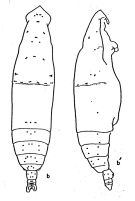 issued from : A. Fleminger in Fishery Bull. natn. Ocean. Atmos. Adm., 1973, 71 (4). [p.989, Fig.13]. Female: b, habitus (dorsal), b', idem (lateral right side).
Dorsal and lateral pattern of integumental organs (black point = sites occuring at 100% frequency, o = 80-99% frequency, x = 10-79% frequency, triangle are sites which are also visible in lateral view but which are assigned to dorsal sets);
|
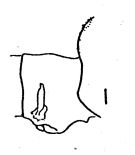 issued from : A. Fleminger in Fishery Bull. natn. Ocean. Atmos. Adm., 1973, 71 (4). [p.968, Fig. l (p.969)]. Female: l, genital segment (lateral right side).
|
 issued from : K.A. Brodsky, N.V. Vyshkvartzeva, M.S. Kos & E.L. Markhaseva in Opred Fauna SSSR, 1983, 135. [p.205, Fig.92]. Female.: habitus (after Fleminger, 1973, redrawn); genital somite; P1.
|
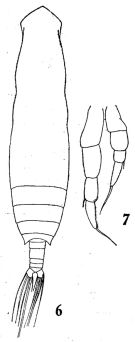 issued from : Q.-c. Chen & S.-z. Zhang & C.-s. Zhu in Studia Marina Sinica, 1974, 9. [Pl.1, Figs.6-7]. Male (from China Seas): 6, habitus (dorsal); 7, P5.
|
 issued from : Z. Zheng, S. Li, S.J. Li & B. Chen in Marine planktonic copepods in Chinese waters. Shanghai Sc. Techn. Press, 1982 [p.116, Fig.6-1]. Female: a, habitus (dorsal); b, forehead (lateral); c-d, urosome (lateral and ventral, respectively); e, A2; f, Md; g, Mx1; h, P1; i, basal portion of P1. Scale bar in mm.
|
 issued from : Z. Zheng, S. Li, S.J. Li & B. Chen in Marine planktonic copepods in Chinese waters. Shanghai Sc. Techn. Press, 1982 [p.117, Fig.6-2]. Male: j, habitus (dorsal); k, forehead (lateral); l-m, urosome (dorsal and lateral, respectively); n, Mx1; o, basal portion of P1; p, P5. Scale bar in mm.
|
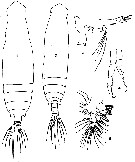 issued from : T. Mori in The pelagic Copepoda from the neighbouring waters of Japan, 1937 (2nd edit., 1964). [Pl.7, Figs.1-5]. Female: 1, habitus (dorsal); 3, Md; 5, Mx1. Nota: Head triangular. Lateral angles of the last thoracic segment pointed. 2 segments between the anal and genital segments. 1st and 2nd segments of exopodite of A2 not fused; 1st segment of endopodite slightly longer than the 2nd, and over 3 times as long as its broad. Inner margin of the 2nd segment of basipodite of Md with 3 setae, divided into 2 nearly equal portions by the insertion of the endopodite; endopodite with 2 setae on the 1st segment, 5 setae on the 2nd. Male: 2, habitus (dorsal); 4, P5.
|
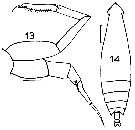 issued from : J.M. Bradford in Mem. N. Z. Oceonogr. Inst., 1972, 54. [p.33, Fig.4 (13-14)]. Female (from Kaikoura, New Zealand): 14, habitus (dorsal). Male: 13, P5. Scale bars: 1 mm (14); 0.1 mm (13).
|
 Issued from : C.O. Esterly in Univ. Calif. Publs Zool., 1916, 16 (14). [p.173, Fig.1]; head (from below view) of Eucalanus. The appendages and bristles are shown diagrammatic. On the left ot the figure are shown, from behind forward, Mx2 (ant. mxp), the outer lobe of Mx1, A2 (post. ant.); on the right appear the inner lobe of Mx1 (mxl) with stiff, heavy bristles and the rami of Md (mnd.), the ''jaw'' being omitted. The shield-shaped prominence in the center of the figure bears the scoop-like lip, within which is the opening of the mouth (mth.). The side of the funnel formed by the bristles of Mx2 is shown on the left of the figure, the other side being omitted for the sake of clearness.
| | | | | Ref. compl.: | | | [Pearson, 1906 (p.4, Rem.)]; ? Esterly, 1916 (p.171, nutrition); 1919 (p.1, 41, light-dark reactions); [Jespersen, 1939 (p.38); Østvedt, 1955 Table 3)]; Yamazi, 1958 (p.147, Rem.); Furuhashi, 1966 a (p.295, vertical distribution in Oyashio/Kuroshio transitional area, Table 7, 10); Timonin, 1971 (p.281, trophic group); Gueredrat, 1971 (p.300, Table 1, 2); Subbaraju & Krishnamurphy, 1972 (p.25, 26 ); [Bainbridge, 1972 (p.61, Appendix Table I: vertical distribution vs day/night)]; [P. Nival & S. Nival, 1973 (p.135, mouth parts, grazing)]; [Harding, 1974 (p.141, Table 2, gut contents); Patel, 1975 (p.659); [Pipe & Coombs, 1980 (p.223, Table II, vertical occurrence)]; Madhupratap & al., 1981 (p.266, fig.1i: abundance vs. geographic transect); Kukina, 1983 (p.355, feeding); Guangshan & Honglin, 1984 (p.118, tab.); Schulz, 1990 (p.188); Madhupratap & Haridas, 1990 (p.305, fig.6: vertical distribution night/day; fig.7: cluster); [Seguin & al., (1993 (p.23, Table 2: abundance, %)]; [Seguin & al., 1994 (p.369, Rem.: p.376: Rem.]; Achuthankutty & al., 1998 (p.1, Table 2, seasonal abundance vs monsoon); ? El-Sherif & Aboul Ezz, 2000 (p.61, Table 3: occurrence); Pakhomov & al., 2000 (p.1663, Table 2, transect Cape Town-SANAE antarctic base); Madhupratap & al., 2001 (p. 1345, vertical distribution vs. O2, figs.4, 5: clusters); Prusova & Smith, 2005 (p.76); Zuo & al., 2006 (p.162: tab.1); [? Khelifi-Touhami & al., 2007 (p.327, Table 1)]; Hwang & al., 2007 (p.24); Dur & al., 2007 (p.197, Table IV); Morales-Ramirez & Suarez-Morales, 2008 (p.519); Wishner & al., 2008 (p.163, Table 2, fig.8, oxycline); Ayon & al., 2008 (p.238, Table 4: Peruvian samples); Rakhesh & al., 2008 (p.154, Table 5: abundance vs stations); [Licandro & Icardi, 2009 (p.17, Table 4)]; [Hafferssas & Seridji, 2010 (p.353, Table 2: as elongates)]; Goetze & Ohman, 2010 (p.2110, Table 1, biogeography); [Mazzocchi & Di Capua, 2010 (p.425)]; [ Medellin-Mora & Navas S., 2010 (p.265, Tab. 2)]; Shanthi & Ramanibai, 2011 (p.132, Table 1); [Andersen N.G. & al., 2011 (p.71, Fig.3: abundance)]; Hsiao S.H. & al., 2011 (p.475, Appendix I); Guo & al., 2011 (p.567, table 2, indicator); Pillai H.U.K. & al., 2011 (p.239, Table 3, vertical distribution); Jose & al., 2012 (p.20, fig.3 a,b,c: % vs monsoon); [Bode & al., 2012 (p.108, spatial distribution vs time-series, % biomass)]; [? Aubry & al., 2012 (p.125, fig.8 a, b, interannual variation)]; [Belmonte & al., 2013 (p.222, Table 2, abundance vs stations)]; in CalCOFI regional list (MDO, Nov. 2013; M. Ohman, comm. pers.); Tseng & al., 2013 (p.507, seasonal abundance); Jagadeesan & al., 2013 (p.27, Table 3, seasonal variation); Anjusha & al., 2013 (p.40, Table 3, abundance & feeding behavior); [ Lidvanov & al., 2013 (p.290, Table 2, % composition) ]; Hwang & al., 2014 (p.43, Appendix A: seasonal abundance); Lopez-Ibarra & al., 2014 (p.453, Rem.: p. 460); Fierro Gonzalvez, 2014 (p.1); Belmonte, 2018 (p.273, Table I: Italian zones) (p.1, Tab. 3, 5, occurrence, abundance); Chiba S. & al., 2015 (p.968, Table 1: length vs climate); [ ? Ben Ltaief & al., 2017 (p.1, Table III, Summer relative abundance); ? El Arraj & al., 2017 (p.272, table 2, spatial distribution); ] ; [ ? Belmonte, 2018 (p.273, Table I: Italian zones); ? Chaouadi & Hafferssas, 2018 (p.913, Table II, III, fig.4: occurrence, abundance, seasonal variation)]. | | | | NZ: | 10 + 2 douteuses | | |
|
Carte de distribution de Eucalanus elongatus par zones géographiques
|
| | | | | | | | | | | |  Issued from : M. Madhupratap & P. Haridas in J. Plankton Res., 12 (2). [p.313, Fig.6]. Issued from : M. Madhupratap & P. Haridas in J. Plankton Res., 12 (2). [p.313, Fig.6].
Vertical distribution of calanoid copepod (mean +1 SE), abundance No/100 m3. 56- Eucalanus elongatus.
Night: shaded, day: unshaded.
Samples collected from 6 stations located off Cochin (India), SE Arabian Sea, November 1983, with a Multiple Closing Plankton Net (mesh aperture 300 µm), in vertical hauls at 4 depth intervalls (0-200, 200-400, 400-600, 600-1000 m). |
| | | | Loc: | | | South Africa (E & ?W), SE Atlant. (in Pakhamov & al., 2000), ? Red Sea (Sharm El-Sheikh), G. of Aden, G. of Oman, Arabian Sea, Laccadive Is., Maldive Is., Madagascar, Indian, India (Saurashtra coast, Porto Novo, Mangalore coast, Goa, Madras, Gulf of Mannar, Palk Bay, Lawson's Bay, Madras, Mandarmani creek, Hooghly estuary, Kakinada Bay), Bay of Bengal, Nicobar Is., Barren Island, W Australia, Indonesia-Malaysia, Viet-Nam (Cauda Bay), China Seas (Yellow Sea, East China Sea, Taiwan Strait, South China Sea), Taiwan, off SW & NE Taiwan, Mienhua Canyon, Kuroshio Current, Okinawa, Korea, Japan, off Hokkaido, Kuril Is., Pacif. (central N), California, W Baja California, off W Guatemala, W Costa Rica, Pacif. (W equatorial), Australia (Great Barrier), New Zealand (Kaikoura), off Juan Fernandez Is., Galapagos-Ecuador, Peru, Chile | | | | N: | 87 ?? (some forms being confused) | | | | Lg.: | | | (28) F: 5,73-4,53; M: 4,46-3,60; (91) F: ± 4,5; M: ± 3,2; (104) M: 4,5; (116) F: 7,1; M: 4,2; (125) F: 5,76-5,62 ; (131) F: 4,53-5,73; M: 3,6-4,46; (150) F: 7-6,5; (290) F: 5,2-5,55; (338) M: 3,5-4,1; (795) F: 5,5; M: 3,8; (991) F: 5,75-8,5; M: 3,75-5; (1023) F: 5,22; M: 4,19; {F: 4,55-8,50; M: 3,20-5,00}
Chiba S. & al., 2015 (p.971, Table 1: Total length female (June-July) = 6.5 mm [optimal SST (°C) = 3.3]. | | | | Rem.: | La répartition géographique est limitée ici à la forme stricto sensu, Indo-Pacifique.
Les variétés sont érigées au rang d'espèces.
Les formes signalées sous cette dénomination par les auteurs entre crochets doivent correspondre vraisemblablement à Eucalanus hyalinus.
Voir aussi les remarques en anglais | | | Dernière mise à jour : 28/10/2022 | |
|
|
 Toute utilisation de ce site pour une publication sera mentionnée avec la référence suivante : Toute utilisation de ce site pour une publication sera mentionnée avec la référence suivante :
Razouls C., Desreumaux N., Kouwenberg J. et de Bovée F., 2005-2024. - Biodiversité des Copépodes planctoniques marins (morphologie, répartition géographique et données biologiques). Sorbonne Université, CNRS. Disponible sur http://copepodes.obs-banyuls.fr [Accédé le 24 avril 2024] © copyright 2005-2024 Sorbonne Université, CNRS
|
|
 |
 |












